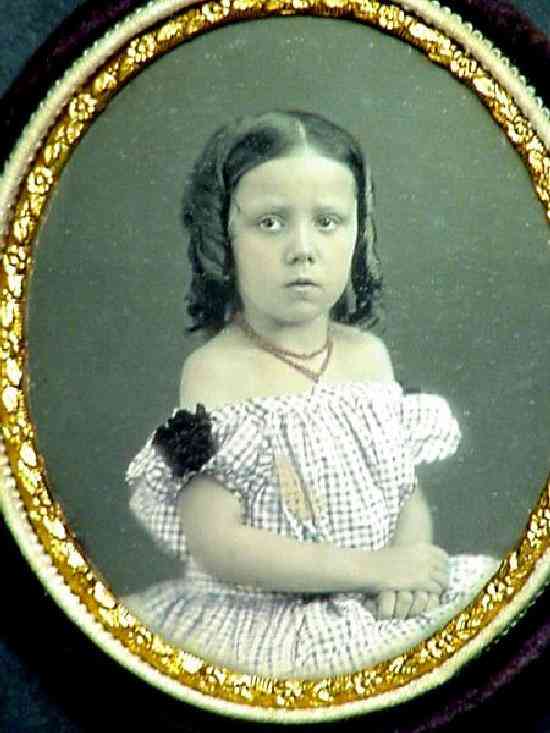Chronology
We would guess that it was taken in the early 1860s, but that is only a rough approximation. Most Daguerrotypes were taken in the 1850s, but Daguerrotypes were still quite common in the early 1860s before CDVs an cabinent cards began to replace them. Thus it is resonable to assume that an undated Daguerreotype was pfrobanly taken in the 1850s, but there were quite a number also taken in the early 1860s. The Daguerreotype here is an extremely high quality one. Thus we think it was probably taken in the late 1850s or early 60s.
Gender
We are also unsure about the child's gender. On images like this are general approach is to assume that it is a girl unless some aspect of the portrait suggests that it is a boy. Thus we would tend to assume that the child here is a girl, although we are not at all sure about that.
Necklace
The necklace rather suggests a girl, but we have noted portraits of boys in dresses wearing necklasses. Notice how the bottom strand peaks down. There was probably a locket attacjed to it.
Dress
The dress here has a low-cut bodice. That was tghe common style during the 1850s and ealy 60s., for both small children (Boys and girls) and women. Not all dresses had these low necklines, but we noticce a number of such dresses. We also note dresses with collars. We are not sure just what these different styles meant. This is a checked dress. We are not sure if this has any gender connontations. We are always curious about plaid dresses which sometimes suggest that the child is a boy. We are not sure if checked dresses have any similar connotations. Note the black device atr the shoulders. This was a morning symbol. The child's mother probably wore a black dress, but it was not considered necessary for children to dress all in black.
Hair Style
This cholsd has ringlets. They are not tightly formed ringlets, but they are ringlets. We nmote American boys wearing ringlets in the 1880s and 90s. We are less sure about the gender conventions for childrens hair during the mid-19th century. Often the center part is a indication the child is a girl, but like so many such indicators it is not a totally reliable indicator.
Reader Comments
One reader writes, "I think this image as you suggest is most likely a firl. I have, however, seen a similar image in a book on the Civil War, which had a photo of Gen. Chamberlain's young son of about 3 or 4 years of age. He was pictured with long ringlet curls parted in the middle and in an off the shoulder dress like the one shown in your image. He was shown lifting he hem of his dress to show show off his frilly pantalets, which his Mother must have been quite proud of."
Another reader writes, "I think the face looks somehow boyish." Here HBC rather agrees, but assessing gender from the faces of young children is difficult and can be misleading.
HBC

[Return to the Main difficult gender page]
[Introduction]
[Activities]
[Biographies]
[Chronology]
[Clothing styles]
[Countries]
[Gender]
[Girls]
[Bibliographies]
[Contributions]
[Essays]
[FAQs]
[Glossaries]
[Links]
[Satellites]
[Tools]
[Boys' Clothing Home]
Created: 6:23 PM 10/25/2004
Last updated: 2:49 AM 10/26/2004



